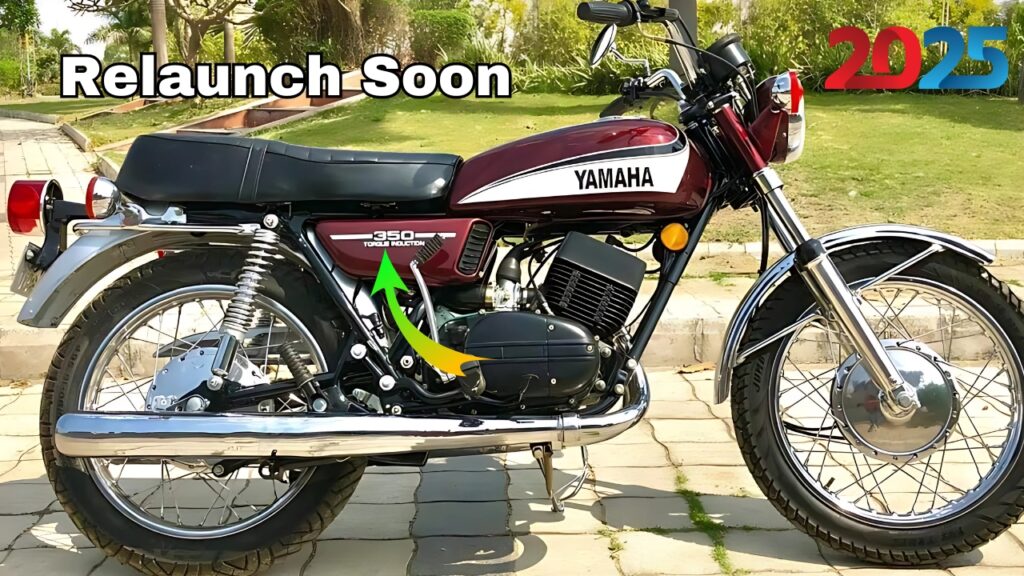Rajdoot 350: In the dynamic world of Indian motorcycling, there’s a buzz in the air—an exhilarating mix of nostalgia and hope. The legendary Rajdoot 350, a motorcycle that once held a special place in the hearts of many, is rumored to be making a comeback.
This talk has ignited excitement among long-time riders who remember its heyday, as well as younger fans who have heard tales of this iconic bike.
But is there any substance to these rumors, or is it merely the wishful thinking of a community eager to relive the glory days of a classic? Let’s take a closer look at the story of the Rajdoot 350 and examine the chances of its resurgence in today’s motorcycle scene.
The Rajdoot 350, or RD 350, was more than just a motorcycle; it was a symbol of power and freedom that defined a generation in Indian motorcycling.
Launched in the 1980s, a time when the Indian market was saturated with basic commuter bikes, this formidable machine was a modified version of the Yamaha RD350B, tailored for local conditions.
Manufactured by the Escorts Group under their Rajdoot brand, it quickly became more than a mode of transport—it turned into a dream machine for speed lovers throughout India.
Equipped with a powerful 347cc, two-stroke, air-cooled parallel-twin engine, the Rajdoot 350 was a force of nature that outperformed its rivals.
The motorcycle was offered in two versions to suit different types of riders: the High Torque (HT) edition, which delivered an impressive 30.5 bhp for speed aficionados, and the Low Torque (LT) version, featuring a more subtle 27 bhp yet providing better fuel efficiency for those seeking practicality.
In its time, the performance of the Rajdoot 350 was groundbreaking, especially when most bikes at the time struggled to muster even half of its power output.
The combination of its brisk acceleration, agile handling, and exceptional performance set benchmarks that resonate with enthusiasts to this day.
Rajdoot 350: The End of an Era
Despite its iconic status and stellar performance, the Rajdoot 350’s time in the spotlight was relatively brief. Production wrapped up in 1990, with the last units rolling out by 1991. A confluence of factors led to its rapid decline:
-
High fuel consumption in a budget-conscious market: The bike’s thirst for fuel became a liability at a time when efficiency was a growing concern for consumers.
-
Steep spare parts and maintenance costs: The sophisticated engineering necessitated costly components that were difficult for the average rider to afford.
-
Shortage of skilled mechanics for complex engines: Maintaining a two-stroke engine required expertise that was not easily available, particularly in smaller towns.
-
Stricter emission regulations threatening two-stroke engines: As environmental standards tightened, the feasibility of two-stroke engines diminished, complicating their future.
The end of the Rajdoot 350 left a gap in the Indian motorcycle market that many believe has yet to be filled, even with a plethora of high-performance bikes introduced afterwards.
Its distinctive mix of raw power, two-stroke engine charm, and affordability forged a legacy that continues to fuel passionate dialogue among motorcycle enthusiasts.
Rajdoot 350: Whispers of Revival
Fast forward to 2025, and chatter about the Rajdoot 350’s possible return is surfacing online. Various news portals and social media channels have sprung to life with images purported to show a new Rajdoot 350, accompanied by specs that seem almost unreal.
Claims of an astounding mileage of 80 kmpl and a launch price of just ₹1 lakh have excited motorcycle fans and set forums ablaze with speculation.
However, it’s essential to approach this excitement with caution. Here’s why:
The overly ambitious claims regarding the new model appear to defy economic and engineering logic, especially given the prevailing market conditions and technological realities. The idea of achieving such high performance and efficiency at such a low price raises significant red flags.
-
Ownership Challenges: The Escorts Group stopped its motorcycle production in 2001 after years of successful operations. Their focus has since shifted entirely to tractors and auto parts, making a return to motorcycle manufacturing a monumental challenge requiring major investment and a rebuild of infrastructure.
-
Brand Recognition: Unlike successful revivals such as Jawa and Yezdi, which maintained a connection with their audiences, the Rajdoot brand hasn’t sustained the same level of recognition among younger generations. Although it has loyal followers, it lacks the cultural cachet that could drive market demand.
-
Technological Hurdles: The idea of reviving a two-stroke engine today conflicts with modern emission standards, especially considering BS6 and future regulations. Creating a new engine that meets performance while conforming to these strict norms would require substantial investment in research and development.
-
Market Dynamics: The suggested price of ₹1 lakh for a 350cc motorcycle amidst current market trends seems implausible. Most contemporary 350cc motorcycles command between ₹2-3 lakhs due to advanced features and strict compliance costs, meaning the rumored price point is unrealistic.
Rajdoot 350: A Reality Check
Examining the current situation surrounding the Rajdoot 350 reveals the rumors may be unfounded. Recent investigations have confirmed that images circulating online are actually of a generic Chinese cruiser, digitally altered to appear as the Rajdoot.
The absence of any official statements from motorcycle manufacturers regarding the Rajdoot brand or RD 350 model further emphasizes the likelihood that these rumors are more fiction than fact.
Rajdoot 350: The Power of Nostalgia
Despite the lack of concrete evidence for a revival, the buzz surrounding the Rajdoot 350 indicates its lasting impact on motorcycle lovers in India. The recent Auto Expo 2025 highlighted this phenomenon, as Yamaha showcased the original RD 350 alongside other classic models like the RX 100, drawing huge crowds.
The display not only honored vintage motorcycles but also formed emotional connections with people of all ages. Older riders reminisced, while young enthusiasts relished the chance to connect with a pivotal chapter in Indian motorcycling history.
This memorable event effectively tied together Yamaha’s rich heritage and its aspirations for the future, demonstrating how legacy can be harnessed to create value in today’s market.
Rajdoot 350: The 350cc Scene Today
While the likelihood of the Rajdoot 350 returning remains slim, the 350cc segment in India is buzzing with new life. Royal Enfield continues to lead the pack with models like the Classic and Meteor, while newcomers like Honda’s H’ness CB350 and Harley-Davidson’s X440 are shaking things up with fresh takes on this popular category.
These modern offerings blend retro styling with the latest technology, appealing to riders seeking both nostalgia and reliability.
Rajdoot 350: An Eye on the Future
The motorcycle industry is at a pivotal point, placing a greater focus on electric mobility and sustainable practices.
While a return of the Rajdoot 350 in its original form seems unlikely, the idea of a spiritual successor is intriguing. An electric bike that mirrors the performance spirit of the original could certainly capture the excitement and passion experienced by riders in the past.
Imagine a modern interpretation of the Rajdoot 350—an electric motorcycle that embodies the essence of its predecessor while adhering to environmental guidelines. Such an innovative approach could revive the thrill that Rajdoot 350 created in the hearts of riders decades ago, paving the way for a greener future.
Rajdoot 350: The Last Word
Even today, the Rajdoot 350’s legacy enchants motorcycle lovers across generations, its influence extending well beyond its production years.
While the prospects of a true revival may lean more toward fantasy, the ongoing conversations and the fervor surrounding the Rajdoot 350 underscore its iconic status within Indian automotive lore.
Engaging debates and discussions about the motorcycle continue, even among younger riders who have never sat on the original, illustrating the cultural significance of the Rajdoot.
At present, the Rajdoot 350 stands as a cherished memory, representing an era characterized by raw energy and simplicity. Its distinctive engine note, thrilling acceleration, and unforgettable design remain alive in stories shared among riders.
These accounts, passed from rider to rider, transform the motorcycle from a mere machine into a legendary figure. As we look ahead to the future of motorcycling in India, we hope that the spirit of innovation and thrill embodied by the Rajdoot 350 will continue to spur manufacturers and enthusiasts, pushing the boundaries of what is possible on two wheels.
Whether or not a new Rajdoot 350 graces Indian roads in the future, its legacy endures in the hearts of those who felt its power and in the dreams of those who imagine its return.
The bike’s legacy is reflected in the growing community of vintage bike restorers dedicated to preserving existing models, the high auction prices these bikes command, and the pride with which they are displayed at classic motorcycle events.
Each restored Rajdoot 350 is a piece of history, narrating the story of the golden age of Indian motorcycling.
Ultimately, it’s this lasting impact—the ability to ignite passion and dedication long after production ceased—that truly defines the Rajdoot 350’s role in the evolution of Indian motorcycling culture.
It serves as a reminder that great motorcycles never die; they become cultural symbols, continuing to inspire future generations.


